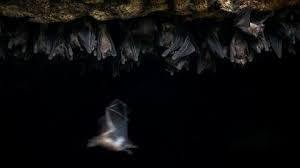Lena H. Sun in The Washington Post:
 By day, some of the most dangerous animals in the world lurk deep inside this cave. Come night, the tiny fruit bats whoosh out, tens of thousands of them at a time, filling the air with their high-pitched chirping before disappearing into the black sky. The bats carry the deadly Marburg virus, as fearsome and mysterious as its cousin Ebola. Scientists know that the virus starts in these animals, and they know that when it spreads to humans it is lethal — Marburg kills up to 9 in 10 of its victims, sometimes within a week. But they don’t know much about what happens in between. That’s where the bats come Prevention traveled here to track their movements in the hopes that spying on their nightly escapades could help prevent the spread of one of the world’s most dreaded diseases. Because there is a close relationship between Marburg and Ebola, the scientists are also hopeful that progress on one virus could help solve the puzzle of the other.
By day, some of the most dangerous animals in the world lurk deep inside this cave. Come night, the tiny fruit bats whoosh out, tens of thousands of them at a time, filling the air with their high-pitched chirping before disappearing into the black sky. The bats carry the deadly Marburg virus, as fearsome and mysterious as its cousin Ebola. Scientists know that the virus starts in these animals, and they know that when it spreads to humans it is lethal — Marburg kills up to 9 in 10 of its victims, sometimes within a week. But they don’t know much about what happens in between. That’s where the bats come Prevention traveled here to track their movements in the hopes that spying on their nightly escapades could help prevent the spread of one of the world’s most dreaded diseases. Because there is a close relationship between Marburg and Ebola, the scientists are also hopeful that progress on one virus could help solve the puzzle of the other.
Their task is to glue tiny GPS trackers on the backs of 20 bats so they can follow their movements.
…Well before you see the bats — about 50,000 live in the cave — you hear their squeaks and chatter and smell the ammonia from their guano, which also covers the cave’s rocky floor. One false step can lead to a fall into a stream underneath. Another could land the scientists on one of the African rock pythons or forest cobras that slither along the ground.
More here.
